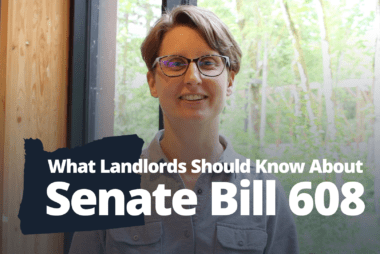Oregon is known throughout the country for having some of the most challenging landlord-tenant laws to navigate and it will be essential for landlords to keep up and be flexible with changes as they come. There has been some conjecture online about what was actually included in Senate Bill 608 and buzz words have been used to cause additional alarm. Hopefully, the information below will give you some peace of mind and understanding about Senate Bill 608.
Disclaimer: The video and content on this page do not, and are not intended to, constitute legal advice. All information and content in this video are for informing landlords about several aspects of Oregon’s Senate Bill 608 only. Contact your attorney to obtain advice with any particular legal matter regarding Senate Bill 608.
Here are some important details that landlords should know:
- All fixed-term leases will now automatically convert to a month-to-month agreement after the fixed term. Our company has always done this as a practice to avoid any potential lapses in rent if a new lease was not signed and tenants stayed in a property. Of course, we still have the option of signing a new fixed-term lease to begin after the current lease expires. This change in the law does not affect our property owners since we always converted leases automatically to month-to-month status.
- We no longer can issue a no-cause notice after the original fixed term of a lease agreement, with a few exceptions. Here’s what we can do:
- We can issue a no-cause 30-day notice for a tenant to move at the end of their fixed-term lease.
- We can issue a no-cause 90-day notice for a tenant to move if there was an offer submitted to buy the property, and the sale will close within 120 days, and either the new owner would occupy the property or repairs to be done at the premises would cause it to become uninhabitable.
- We can issue a no-cause 90-day notice if there were three violations of a lease agreement during the fixed term and if the violation notices included wording that the notice could be issued after three or more violations. There would then be no remedy for the notice.
- Of course, we can still issue a 30-day notice with cause at any time if there is a violation of the lease agreement or landlord-tenant law. Keep in mind that all notice periods are a minimum; we can issue a longer notice if we choose.
The disadvantage to a rental property owner or property manager is that if there is a difficult tenant, but we cannot cite them with a specific violation, the owner or manager is stuck with them once they have resided in the property longer than the original fixed term of their lease. The key to working with this aspect of the new law will be that if tenants are particularly hard to deal with, it might be better to have them move at the end of their original lease term. The downside to this strategy is that an owner would then have another vacancy to deal with. We would always approach one of our owner clients first with a scenario to discuss the pros and cons of terminating a tenant at the end of the original lease term before ever issuing a notice to terminate the tenancy.
- Rent increases are now limited to once per year and capped at a rate of 7% + the rate of inflation. The inflation rate to which this law refers is adjusted monthly and is the “Consumer Price Index – West Region” rate for “All Items,” but the number used is taken from September of the previous year. The US Department of Labor and Statistics issues a monthly update detailing any changes from the month before and previous years. The 90-day rent increase notice requirement is still in effect as well.
- Strategies for rent increases: More often than not, unless an owner had requested otherwise, we have increased rents at moderate rates once per year. This is because most of our clients are seeking long-term benefit from their investment properties and keeping tenants in a property is a higher priority than getting the top market rent rate. For these owners and their properties, our standard practice would be well within the new law. However, we do have some owners who want maximum market rent all the time even if vacancy rates increase. That strategy is typically utilized by those seeking to maximize the resale value of the income-producing property rather than their monthly income. Still yet, we have a few owners who want below-market rent rates to help families who might need a more affordable place to live and to reduce their annual taxable income.
Because the Oregon Legislature has not yet published the 2019 version of the Oregon Revised Statutes, we must refer to the bill text which is online at: https://olis.leg.state.or.
We are waiting to hear about other ideas being discussed by some of the legislators, which include possible changes to pet policies and criminal background checks.
Many of our owner clients, and also private landlords, have been calling asking us about these laws so we felt it was important to put out some essential information for our clients to reference. As a property management company, we have learned to pay attention, deal with emergencies and urgent matters calmly, and comply with laws as they are written. We are here to manage your investment property legally and the best that we possibly can.
If you have any additional questions regarding Senate Bill 608, feel free to contact us at office@cpmoregon.com.









